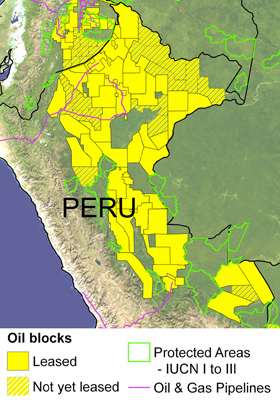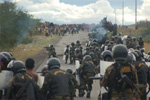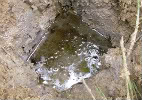A new study in the Environmental Research Letter finds that the Peruvian Amazon is being overrun by the oil and gas industries. According to the study 41 percent of the Peruvian Amazon is currently covered by 52 active oil and gas concessions, nearly six times as much land as was covered in 2003.
“We found that more of the Peruvian Amazon has recently been leased to oil and gas companies than at any other time on record,” explained co-author Dr. Matt Finer of the Washington DC-based Save America’s Forests in a press release. The concessions even surpass the oil boom in the region during the 1970s and 80s, which resulted in extensive environmental damage.
The authors say that what’s even more worrisome is that many of today’s concessions infringe on state protected areas and indigenous lands.
 Oil and gas blocks in the western Amazon. Solid yellow indicates blocks already leased out to companies. Hashed yellow indicates proposed blocks or blocks still in the negotiation phase. Protected areas shown are those considered strictly protected by the IUCN (categories I to III). Image modified from Finer M, Jenkins CN, Pimm SL, Keane B, Ross C, 2008 Oil and Gas Projects in the Western Amazon: Threats to Wilderness, Biodiversity, and Indigenous Peoples. PLoS ONE 3(8): e2932. doi:10.1371/journal.pone.0002932 |
“Nearly one-fifth of the protected areas and over half of all titled indigenous lands in the Peruvian Amazon are now covered by hydrocarbon [i.e. oil and gas] concessions,” says co-author Martí Orta-Martínez of the Universitat Autònoma de Barcelona. “And perhaps most disturbingly, we found that over 60 percent of the area proposed as reserves for indigenous peoples in voluntary isolation are covered by oil concessions. These uncontacted people are extremely vulnerable to outside illness.”
Despite concerns for the environment and indigenous peoples, the boom shows no sign of slowing down. According to study the amount of area leased to oil and gas is on track to nearly double, reaching approximately 70 percent of the total Peruvian Amazon. Already, over the next five years seismic testing and well production are set to hit levels not seen since the oil boom of the 1970s.
“The first hydrocarbon boom of the early 1970s brought with it severe negative environmental and social impacts,” said Orta-Martínez. “Unfortunately, all indications are that this second boom will as well.”
“Case in point is the extremely controversial Block 67,” adds Finer. “This block is located in one of the most mega-diverse and intact corners of the Amazon, but it is slated for major development as it sits on top of over 300 million barrels of probable oil reserves.”
In addition Block 67 overlaps with a proposal for a reserve to protect an uncontacted indigenous tribe in the area.
The authors suggest that Peru should follow the example Ecuador’s Yasuni-ITT initiative, which proposes to leave oil in the ground for compensation from industrialized nations in order to preserve biodiversity, sequester carbon, and respect indigenous rights.
Conflict has already erupted over the concessions. Last year indigenous protestors clashed with government police at Bagua leading to the deaths of 23 police officers and at least 10 indigenous peopled. In the aftermath protestors accused police of burning bodies or throwing them in rivers to hide the total dead.
Peruvian President Alan Garcia, who has aggressively pushed the concessions, has refused to meet with indigenous leaders. He has referred to Peru’s indigenous people as “confused savages”, “barbaric”, “second-class citizens”, “criminals”, and “ignorant”, even comparing tribal peoples to Peru’s infamous past terrorist group, the Shining Path.
CITATION: Matt Finer and Martí Orta-Martínez 2010 Environ. Res. Lett. 5 014012 doi: 10.1088/1748-9326/5/1/014012
Related articles

(12/22/2009) In James Cameron’s newest film Avatar an alien tribe on a distant planet fights to save their forest home from human invaders bent on mining the planet. The mining company has brought in ex-marines for ‘security’ and will stop at nothing, not even genocide, to secure profits for its shareholders. While Cameron’s film takes place on a planet sporting six-legged rhinos and massive flying lizards, the struggle between corporations and indigenous people is hardly science fiction.
Heavy oil pollution remains in Amazon, despite company claiming clean-up is finished

(09/17/2009) A new report shows that the Corrientes region of the Peruvian Amazon, which suffered decades of toxic contamination by Occidental Petroleum (OXY), is far from being cleaned-up. The survey, conducted by US non-profit E-Tech International, found that heavy metals, volatile organic compounds, and hydrocarbons still exist at levels above the safety limits set by Peru and continue to threaten the Achuar indigenous community, who have long fought against the oil companies.
Police face murder charges in killing of indigenous protesters in Peru
(08/16/2009) A federal prosecutor in Peru filed murder charges against two police generals and 15 other officers over the deaths of indigenous protesters at a roadblock in June, reports the Associated Press. The Indians were protesting new rules that would have made it easier for foreign developers to exploit oil and gas, timber, and minerals in Peru’s Amazon rainforest. The skirmish left 23 police and at least ten protesters dead.







